Yoga Nidra for Beginners
Yoga Nidra, also known as “yogic sleep,” is a powerful meditation and relaxation technique that has been practised for thousands of years. It involves entering a state of conscious relaxation that lies between wakefulness and sleep, allowing you to access deeper states of awareness and healing. In this article on Yoga Nidra for beginners, we will explore its origins, benefits, and a step-by-step method for you to practice. Enjoy the experience.

This article contains some affiliate links, which means that if you decide to buy, I may receive a small commission at no extra cost to you. As an Amazon Associate, I earn from qualifying purchases. This helps me keep The Creative Choice growing and free for readers. Thank you for your support. For more information, see our Affiliate Disclosure.
Origins of Yoga Nidra
Yoga Nidra has its roots in ancient Indian traditions and scriptures, including the Upanishads and Tantras. Swami Satyananda Saraswati, a renowned yoga master, is credited with bringing Yoga Nidra to the modern world. In the mid-20th century, he developed a structured method for practising Yoga Nidra, which is now widely taught and practised worldwide. When you think of yoga, especially as a beginner, you may think about complex poses and almost inhuman flexibility that can appear impossible for the beginner to master. However, Yoga Nidra is a very different form of yoga and is based on meditation and relaxation, not physical poses. It differs from other types of yoga in several key ways:
Focus on relaxation: Unlike more physically demanding forms of yoga, Yoga Nidra is primarily a practice of conscious relaxation. While Hatha, Vinyasa, and Ashtanga yoga emphasise physical postures (called asanas) and movement, Yoga Nidra is performed lying down in a comfortable position and is a great way to get started with meditation.
Meditative practice: Yoga Nidra is a guided meditation that leads you into a state between wakefulness and sleep. It involves a systematic process of deep relaxation, body scanning, breath awareness, and visualisation. Yoga Nidra is a perfect introduction to meditation for beginners.
No physical effort: There are no physical postures or movements in Yoga Nidra, making it accessible to people of all ages and physical abilities. It is often practised at the end of a physical yoga session as a form of Savasana (Corpse Pose) but it can be practised on its own.
Mental and emotional healing: Yoga Nidra places a strong emphasis on mental and emotional well-being and many people begin doing Yoga Nidra to help with some kind of emotional stress or anxiety release. It helps to release stress, anxiety, and suppressed emotions, promoting deep psychological healing.
Use of Sankalpa: One unique aspect of Yoga Nidra is the use of a ‘Sankalpa’, or positive intention formed by the heart and mind. At the beginning of the practice, you set a Sankalpa, which is a short, affirmative statement that reflects your deepest desire or goal. This intention is revisited throughout the session, helping to align the subconscious mind with your conscious goals. There are some examples of Sankalpa intentions later in this article.
Altered states of consciousness: Yoga Nidra facilitates access to altered states of consciousness, such as the hypnagogic state (the transitional state between wakefulness and sleep). This can be a gateway to deeper states of awareness, self-discovery, and even experiences like astral projection.
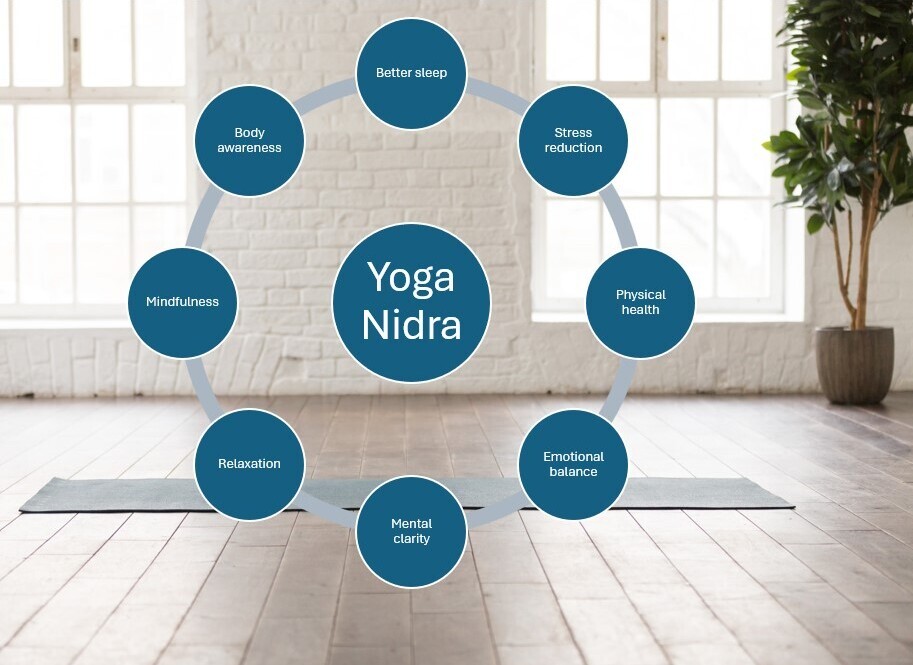
Benefits of Yoga Nidra and Scientific Research:
There is a growing body of scientific research supporting the benefits of Yoga Nidra for a number of physical and emotional markers including:
- Stress Reduction: Yoga Nidra is highly effective in reducing stress and anxiety. A study published in Current Psychology found that participants who practised Yoga Nidra for 30 days experienced lower stress levels and improved well-being compared to a control group
- Improved Sleep: Regular practice of Yoga Nidra can enhance the quality of sleep and alleviate insomnia. The same study showed that participants reported better sleep quality after the intervention
- Emotional Healing: Yoga Nidra provides a safe space for exploring and releasing suppressed emotions. It can help in processing trauma, grief, and other emotional challenges
- Enhanced Focus and Clarity: Practising Yoga Nidra improves concentration, mental clarity, and cognitive function. It enhances creativity and problem-solving abilities
- Physical Healing: The deep relaxation achieved during Yoga Nidra promotes physical healing by reducing inflammation, lowering blood pressure, and improving overall health
This evidence-based research includes:
- The Origin and Clinical Relevance of Yoga Nidra – This review article discusses the physiological and psychological effects of Yoga Nidra, including improvements in haematological variables, red blood cell counts, blood glucose levels, and hormonal status. It also mentions its impact on reducing symptoms of mild depression and anxiety.
- Effectiveness of a short Yoga Nidra meditation on stress, sleep, and well-being – This study found that an 11-minute Yoga Nidra meditation significantly reduced stress, improved sleep quality, and increased well-being and general life satisfaction in a large and diverse sample.
- The Science of Yoga Nidra – This article explores the neurological basis of Yoga Nidra, highlighting its impact on brainwave patterns and its ability to induce deep relaxation and improved sleep quality.

The Practice of Yoga Nidra for Beginners
Yoga Nidra is typically practised lying down on your back in a comfortable position, known as Savasana (Corpse Pose). It is not required to lie completely flat as some people may prefer to use cushions or pillows to support themselves and this is totally fine. You can practise for as long as you want. Research has shown that as little as 11 minutes a day can bring benefits but many people choose to meditate for longer, perhaps 20 -30 minutes or possibly an hour at a time.
The practice involves the following steps:
1) Preparation: Find a quiet space where you won’t be disturbed. Lie down on your back with your arms by your sides and palms facing up if you can. Close your eyes and take a few deep breaths to relax.
2) Setting an intention: At the beginning of the practice, set a positive intention or Sankalpa. This is a short, affirmative statement that reflects your deepest desire or goal. Repeat it silently to yourself. Sankalpa, or heartfelt intention, is a powerful aspect of Yoga Nidra. It’s essentially a positive resolve or affirmation that resonates deeply with you such as:
“I am at peace with myself and the world around me.”
“I radiate health, happiness, and well-being.”
“I trust the process of life and surrender to its flow.”
“I am worthy of love, joy, and abundance.”
“I embrace every moment with gratitude and acceptance.”
“I am strong, resilient, and capable.”
“My mind is calm, clear, and focused.”
The most important aspect of a Sankalpa is that it feels true and meaningful to you.
3) Body scan: The guide or instructor will lead you through a systematic body scan, bringing awareness to each part of your body. This helps to release tension and promote relaxation. When starting out, Yoga Nidra is best done with an instructor or a guided meditation as this will lead you through the process thoroughly. However, it is also possible to do your own self-guided technique once you are more familiar and confident with the process.
4) Breath awareness: Focus on your breath, observing the natural rhythm of inhalation and exhalation. This helps to calm the mind and deepen the state of relaxation. You may find it useful to perform 3 longer inhalations and exhalations at the start of the meditation as this can have an instant relaxing effect on the body.
5) Visualisation: If using a guided meditation, the guide may lead you through a series of visualisations, such as imagining a peaceful place or a healing light. Visualisation can enhance the meditative experience and promote inner healing.
6) Rotation of consciousness: The practice involves moving awareness systematically through different parts of the body, often following the guide’s instructions if you are using guided meditation. This helps to deepen the state of relaxation and access the subconscious layers of the mind.
7) Ending the session: Gradually bring your awareness back to the present moment. Reflect on your Sankalpa and repeat it silently. Take a few deep breaths and slowly open your eyes when you are ready. Drinking water is recommended after the session to rehydrate yourself.

Yoga Nidra for Beginners – Top Tips
Everyone has to start somewhere and there is very little to get ‘wrong’ with Yoga Nidra, so it is a great place to start when beginning any yoga or meditation practice. Some people like to dress in special clothes or use a yoga mat, but there really is no need for specialist equipment when you start out.
Here are some simple tips for beginners starting Yoga Nidra, which can also serve as a reminder for more experienced practitioners.
- Ensure you are comfortable and warm: Find a quiet, comfortable place where you won’t be disturbed. Use a yoga mat, blankets and pillows to make yourself cosy if you wish. Many beginners also like to use an eye mask to help cut out extraneous light when they first start. Also remember to shut the door temporarily on any pets you have. It can be a great distraction to be woken up mid meditation by the cat!
- Start small: Begin with shorter sessions, around 10-20 minutes, and gradually increase the duration as you become more comfortable with the practice.
- Use guided sessions in the beginning: As previously mentioned, when you are starting out, it is usual to follow guided Yoga Nidra sessions of which there are many readily available online, through meditation apps or find a local yoga teacher and join a group. This will help you get familiar with the process and stay focused.
- Remember to set your intention (Sankalpa): Before you start, set a positive intention which you may find useful to write down in a yoga journal. Repeat it silently at the beginning and end of your practice.
- Relax completely: Allow yourself to fully relax and let go of any tension you may be holding in your body. It’s normal for your mind to wander; gently bring your focus back to the guidance without judgment and give yourself time to settle into the process.
- Try to stay still: Try to remain as still as possible during the session. Movement can disrupt the relaxation process but beginners often find it difficult to remain motionless at first. Don’t worry if you need to move or adjust your postion. If you do, do so slowly and mindfully.
- Practice regularly: As with any new skill, practice helps improve your abilities. Consistency is key in meditation too. Aim to practice Yoga Nidra a few times a week, if not daily, to experience the full benefits.
- Be patient: It may take time to fully experience the depths of Yoga Nidra. Be patient with yourself and enjoy the journey.
- Stay hydrated: Drink water before and after your practice to stay hydrated and help your body detoxify.
- Reflect afterwards: Take a few moments after your practice to sit quietly and reflect on your experience. Notice any changes in your body, mind, and emotions. You may find it useful to use a dedicated yoga journal to chart how you feel before and after the sessions, and how you feel about your Sankalpa. If you fall asleep, don’t worry, you will still gain a lot of benefits from a good sleep!
Remember, Yoga Nidra is a journey of self-discovery and relaxation. There is no perfect or right or wrong way to experience it, so trust the process and enjoy the benefits it brings. Yoga Nidra can become a transformative practice for you that offers profound benefits for your body, mind, and spirit. Whether you are seeking relaxation, healing, or personal growth, Yoga Nidra can be a valuable addition to your wellness routine and by dedicating time to this practice, you can cultivate a deeper connection with yourself and experience a greater sense of peace and well-being.
And it can be done by anyone, almost anywhere!!

Yoga Nidra Courses
- Yoga Nidra Network: Offers a variety of online courses, including teacher training, online retreats, and monthly classes. They also have an extensive library of Yoga Nidra practices in multiple languages.
- Nada Yoga School: Provides a 15-hour online Yoga Nidra Facilitation Course, which covers the ancient wisdom of Yoga Nidra and practical teaching techniques.
Related articles
Yoga for Beginners Over 50: How to Start Practicing
Beginner’s Guide To Meditation And Its Benefits
Ready, Steady, Go..SLOW – The law of attraction and meditation
Below are some useful resources you may like for your Yoga Nidra practice. Some links are affiliate links. As an Amazon Associate, I earn from qualifying purchases but this will not affect or increase the price you pay.. This helps me keep The Creative Choice growing and free for readers. Thank you for your support. For more information, see our Affiliate Disclosure.T

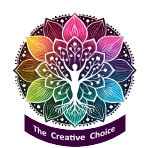
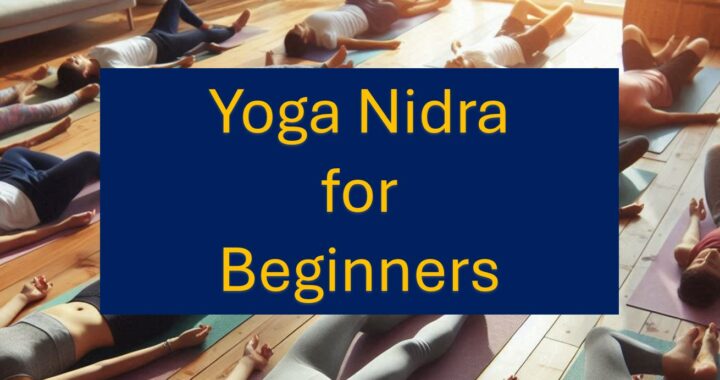
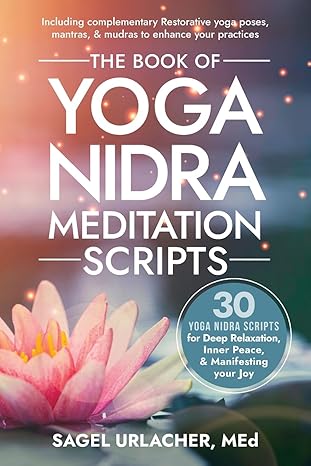
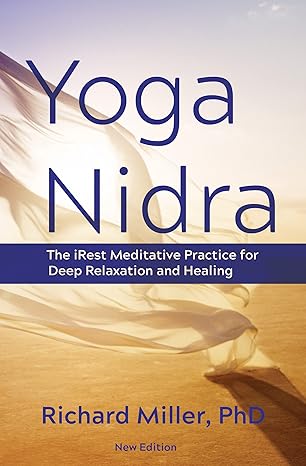
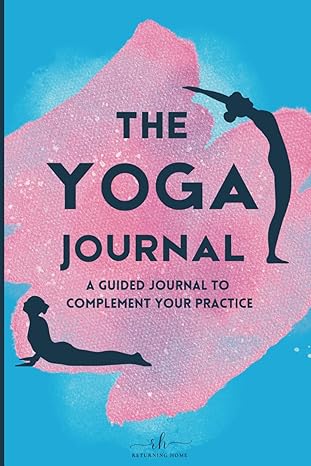
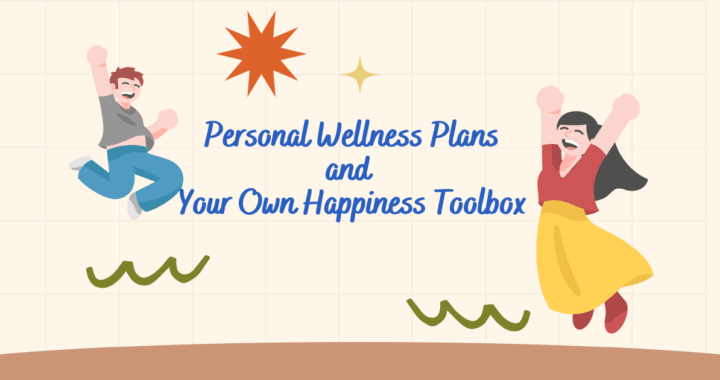
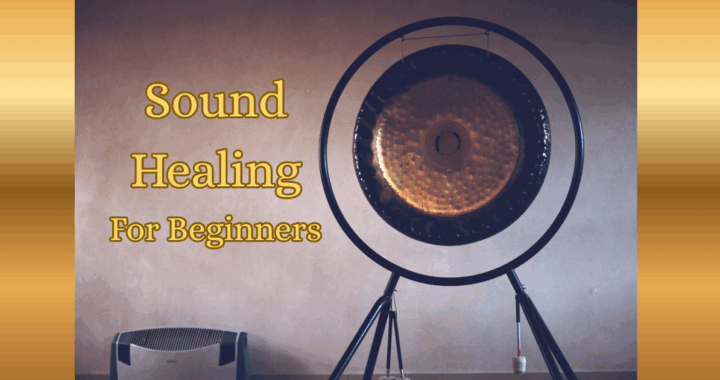

Hi Gail,
This article provides an excellent introduction to Yoga Nidra, or “yogic sleep,” making it accessible for beginners by detailing its origins, benefits, and step-by-step practice methods. It effectively highlights how Yoga Nidra stands apart from other yoga forms by focusing on relaxation and mental well-being rather than physical postures.
The inclusion of practical tips, such as using guided sessions and setting intentions (Sankalpa), ensures that newcomers feel supported in starting their journey. With insights into scientific research and the profound healing potential of Yoga Nidra, this comprehensive guide invites readers to explore a transformative practice that nurtures both mind and body.
Cheers
John
Thanks for your kind comments, John. I hope you have a go at Yoga Nidra yourself and like the benefits that you get.
Thank you in the very enlightening article on Yoga Nidra. It sounds similar to other meditation practices I have done but without making the intention at the beginning and end. I really like this idea and will practise it. Do you know of any guided yoga Nidra practices that are free or can you recommend any particular teachers that offer guided practice on platforms such as you tube or Spotify? Thanks
Hi Lyn. Thanks for your comment and I’m glad that you’re using meditation in your daily life. It really is a great antidote to the stresses of modern living. There are a lot of free meditations on YouTube, which is where I tend to look and I particularly like a lady called Rosallie (search for “Rosalie Yoga”. You can find some great guided meditations on her channel.
This is a wonderful post on Yoga Nidra for beginners! I love how you’ve broken down the practice in such an approachable way, making it easy for newcomers to understand and start incorporating it into their routine. From my experience, Yoga Nidra is an incredibly relaxing and restorative practice, and I appreciate how you’ve emphasized its benefits for stress reduction, improved sleep, and overall mental clarity. The step-by-step instructions are particularly helpful for those who may feel intimidated by meditation or mindfulness practices.
One question I have is: How do you recommend incorporating Yoga Nidra into a daily routine, especially for beginners who might have trouble sitting still or relaxing fully at first? I’ve found that it can take some time to get comfortable with the practice, so any tips on making it easier to dive in would be great. Additionally, are there any specific times of day that are most beneficial for practicing Yoga Nidra to enhance its effectiveness?
Overall, this post provides a fantastic introduction to Yoga Nidra, and it’s clear how beneficial it can be for both physical and mental well-being. I’m excited to incorporate this practice into my routine! Thanks for sharing such a helpful guide!
Hi there and thanks for your comments. I’m glad you found the article useful and that you have been practising it yourself too. To answer your question, I think the best advice I can give is for beginners to start small and to practise for small amounts of time to start with – maybe only 10 minutes. Focusing on your breathing at the start also helps, and if you don’t get through all your body in that time, then be kind to yourself, and don’t worry about it. There really are no hard and fast rules as such, and the best thing to do is start at your own pace and follow that. After all, if you start listening to your body, it will tell you what it needs.